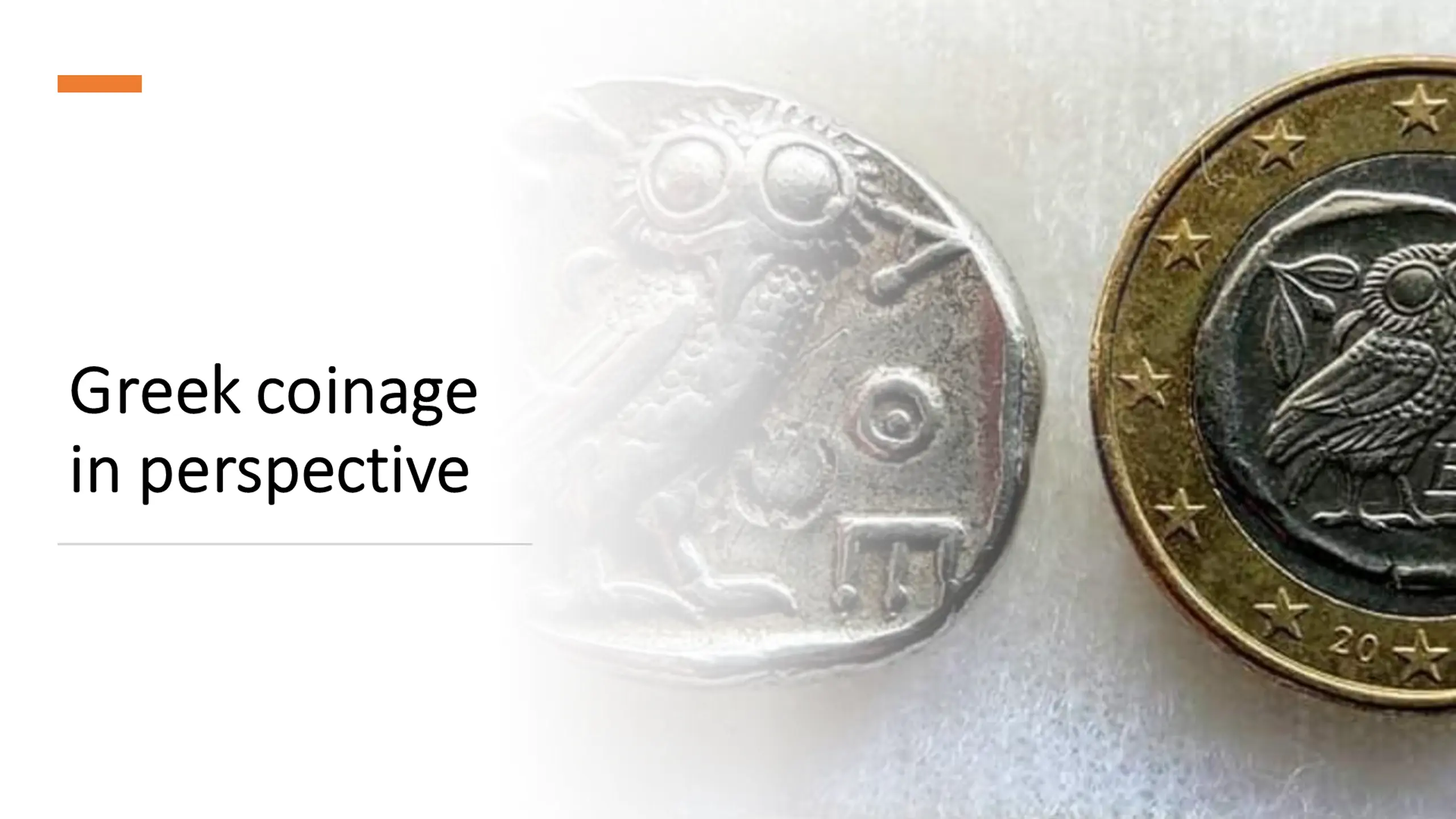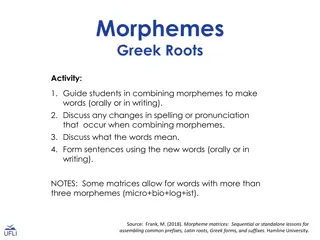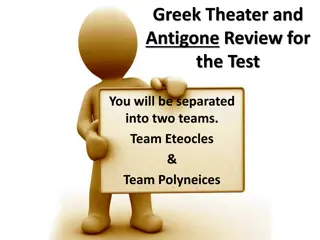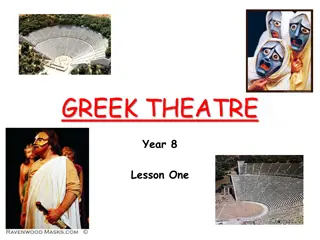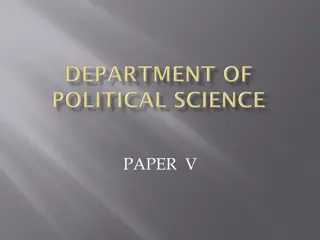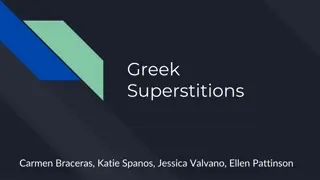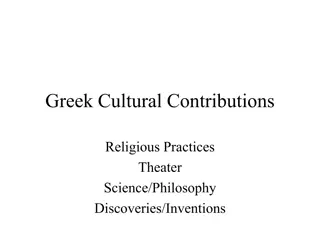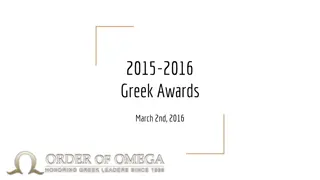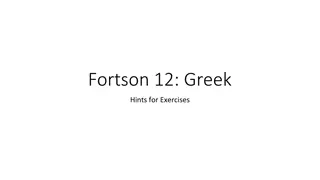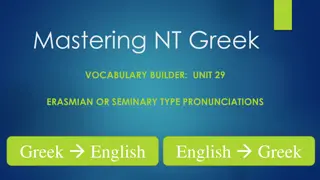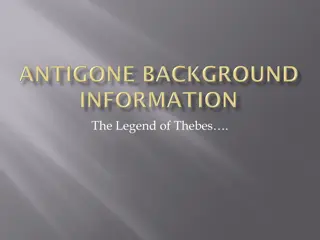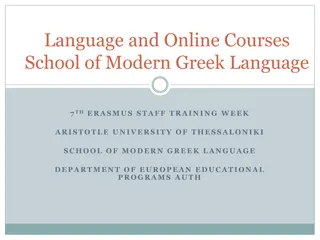Greek coinage in perspective
Explore ancient Greek coinage practices and their modern parallels. Discover attitudes, practices, and the intersection of money with propaganda throughout history.
Download Presentation

Please find below an Image/Link to download the presentation.
The content on the website is provided AS IS for your information and personal use only. It may not be sold, licensed, or shared on other websites without obtaining consent from the author.If you encounter any issues during the download, it is possible that the publisher has removed the file from their server.
You are allowed to download the files provided on this website for personal or commercial use, subject to the condition that they are used lawfully. All files are the property of their respective owners.
The content on the website is provided AS IS for your information and personal use only. It may not be sold, licensed, or shared on other websites without obtaining consent from the author.
E N D
Presentation Transcript
Greek coinage Greek coinage in perspective in perspective
Attitudes to coinage/currency Counterfeits and producing counterfeits condemned Hoarding/ saving money Spending money Work/services being paid in money Payment of fines Appreciating an individual s character in terms of his relationship to money , cf. Thephrastus, Charecters IV, 11 (Testimonia Numaria A24)
Practices connected to money unchanged from Antiquity to the Present Counterfeits/forgeries and producing counterfeits/forgeries condemned Selling and buying Loans/ borrowing at an interest Banks and the operation of banks Fund raising Accounts Public expenditure War reparations Precious metal currency vs small change for every day transactions
Type design Type design
Money and propaganda Money and propaganda To enhance the moral just as the images on the Greek banknotes during German Occupation To commemorate historical events or anniversaries To express common ethnic identity Political propaganda, e.g. on RRC, the propaganda coins of Thomas Spense and his contemporaries National policies, war propaganda, e.g. Propagand banknotes of the Vietnam war, the use of forged, parodied or overprinted currency to make a parody of the enemy Forged currency in warfare. The Germans forged millions of British pounds during World War Two in an attempt to undermine the British economy.
Chinese money Chinese money - Cypraea moneta (money cowrie), Cypraea annulus (ring cowrie) - Bronze cowrie use during eastern Zhou period (770-222 BCE) (tong bei) - Chu state (475-222 BCE): cowrie money with inscriptions. Mould also found. - Qin unification in 221 BCE standardized currency, removal of cowrie currency
Bronze Bronze qin ban liang qin ban liang 400-100 BCE, Yale University Art Gallery 2001.87.45339. 6.43g, 32.28 mm
Money in India Money in India Proto-coinage (bent silver bars) perhaps influenced by Greek coinage via Achaemenid Persia. Achaemenid kings: Greek coins circulated as monetary bullion into Afghanistan. Coins of Alexander found in north Pakistan. Gradual adoption of dies rather than punch striking. Periplus of the Erythraean Sea (mid first century AD) refers to the circulation of coins of the Greek kings of the Punjab in western India.
Silver drachm of Nahapana with Indian language written in Greek on the obverse naming him as ruler. Arrow and thunderbolt on the reverse with Kharoshthi and Brahmi inscription versions of the inscription written in Greek. AD 30-70
Coinage which appeared simultaneously in the Greek world as well as in at least two other parts of the world, in India and in China - is an unsurpassed invention. It can only be surpassed by the cashless payments of our modern, digital era. Once invented, it has never been abandoned
A means of commensuration A means to overcome the obvious difficulty deriving from the double coincidence of wants Money establishing fairness in transactions in a primordial level Ascribing value in terms of its cost in money A means of depositing wealth and a means of assessing the magnitude of wealth, e.g. the inventories of deposits in ancient Greek sancturies, estimating the cost
Numismatics in the Renaissance Numismatics in the Renaissance M rkholm 1979: ancient Greek numismatic scholarship begins in 1760. Interest in Greek coins much less than Roman coinage (portraits of rulers) before 16thcentury. Some interest (Ciriaco d Ancona and Ambrogio Traversari) but knowledge of ancient Greek limited during 15thcentury Turkish conquest of Greece made it difficult to travel to Greece/Asia Minor to record antiquities 16thcentury: references to Greek coinage in Bud and Leonardo da Porto. Also knowledge of Greek increased.
Promptuaire des Medalles des plus renomm es personnes Guillaume Rouill 1581 De Asse et partibus, 1514. Guillaume Bud
Kagan: There has been an underestimation Kagan: There has been an underestimation Those knowledgeable about Greek coins in this period either didn t try to publish or died while writing their works. E.g. Fulvio Orsini letters, collection contained 800 Greek coins, known expertise Wolgang Lazius, 1558, Commentarium rerum Graecarum libri duo
Cyriacus Cyriacus of Ancona of Ancona father of archaeology Rhodian coins identified Apollo on obverse and knew the significance of the flower. Evidence for Venetian trade in Greek coins in 15thcentury
Joseph Joseph Eckhel Eckhel Doctrina numorum veterum (8 vols, Vienna 1792 1798)
The market: the coin of coins The market: the coin of coins AR Tetradrachm of Aetna, from the same engraver as the Naxos series. Aetna, Sicily, AR tetradrachm. 17.23 gr, 26mm. 476-431 BC. AITNAION, head of the satyr Silenos, bald and bearded, right, with pointed horse s ear, and wearing a wreath of ivy wreath, beetle below / Zeus Aitnaios seated right on ornamented throne covered with a panther s skin, himation draped over his left shoulder and arm, holding thunderbolt and a knotted vine staff bent into a crook at the top; to right a pine tree with an eagle perched on top. Hill, Coins of Ancient Sicily, P. 74 and Pl. 4, 13. Now in Brussels coin cabinet, unique, said to be the most expensive/valuable coin in the world.
Aetna master One example sold $994,500 in early 2012 as part of the Prospero Collection sold Jan. 4 by the New York Sale consortium (Baldwin s, Dmitry Markov and M&M Numismatics).
decadrachm of Agrigentum $2,918,810 U.S
Gold EID MAR denarius Gold EID MAR denarius One of three examples known, said to have a pre WWII provenance From the collection of the Baron Dominique de Chambrier . May 31 by Numismatica Ars Classica - sold for $4,174,950.
Repatriation Repatriation The provenance found to be invented for the EID MAR gold coin and a Naxos tetradrachm that sold for $291,682. Both coins were given the same provenance: From the collection of the Baron Dominique de Chambrier, original attestation of provenance included; ex collection of Bernhard de Chambrier (1878-1963) and Marie Alvine Irma von Bonstetten (1893-1968); ex collection of Baron Gustave Charles Ferdinand von Bonstetten, Chamberlain to Ferdinand I, Emperor of Austria . Richard Beale, Roma nunmismatics, arrested in New York: unlawful acquisition of coins from Italy, Greece and the Gaza strip. Italo Vecchi named as co-conspirator. Naxos coin repatriated to Italy EID MAR coin recently repatriated to Greece.
Coins were and are still considered Works of art They are Produced by engravers It is derived from Greek antiquity The expectation to have beautiful, well-worked and fine in their details coins
Political union Materialised in the issuing and circulation of the same currency: common monetary zone Monetary expansionism as a form of political prevalence, e.g. the dollar in the second half of the 20thcentury
Money and the state State as a guarantor of the money: genuine, acceptance in the market Mintmark or the signatures/signs of the mintmaster Coinage and its imagery as symbols of power , cf. Mark XII, 13-17 = Testimonia Numaria A22 The image of sovereigns on the coins even on Euro coins (!)
Blockchain, tokens, and ancient Greek Blockchain, tokens, and ancient Greek tokens/democracy tokens/democracy Agora: voting papers registered on a blockchain which could then validate and tally the results. Sierra Leone for presidential election. Explicit invocation of the governmental systems of ancient Athens The story of fifth century Athenian tokens and voting by allotment is a story of aristocrats competing over the demos and the long hold of a politics of honour in the process of transforming into a politics of civic virtue. Blockchain projects, by misrecognizing their own nature and reading into themselves their own libertarian version of the Agora, miss the relationships of hierarchy subtending them. They thus also displace the possibility of virtue onto a flattened out idea of direct democracy which was never obtained in Athens in the way they imagine. Maurer p. 217
Other ideas? Other ideas?
Further Reading Further Reading Cribb, J., 2003. The origins of the Indian coinage tradition , South Asian Studies, 1-19. DuPont, Q., Gkikaki, M., Rowan C. (2020). DAO, Blockchain and cryptography: a conversation with Quinn duPoint , Warwick Exchanges 7(3), 103-117 Kagan, J., (2013) Notes on the study of Greek coins in the Renaissance in U. Peter and B. Weisser (eds), Translatio Nummorum. R mische Kaiser in der Renaissance, Berlin, 57-70 M rkholm, O. 1979-80. A history of the study of Greek numismatics , Nordisk Numismatisk rsskrift p. 5-21. Maurer, B. 2019. The politics of token economics, then and now, in Cris , A., Gkikaki, M.,and Rowan C., (eds),Tokens. Culture, Connections, Communities, London: Royal Numismatic Society Special Publication No. 57, pp.215-229. https://numismatics.org.uk/wp-content/uploads/2020/01/Tokens_ed_crisa_gkikaki_rowan.pdf Rowan, C. (2019) Money and the Issues of the Age , in S. Krmnicek (ed.) A Cultural History of Money in Antiquity, Bloomsbury, London, 141-160 Yang, B., (2011) The rise and fall of cowrie shells: the Asian story , Journal of World History 22, pp. 1-25
